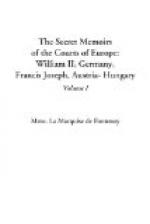All the recognized authorities, both Teuton and foreign, in questions of art and architecture, have pronounced themselves in this sense, the only discordant note being that to which the emperor has given utterance. Not only has he publicly declared the new Reichshaus to be “the very acme of bad taste,” but he even went to the length of striking the designer’s name from the list of gold medalists at the exhibition of art and architecture held at Berlin shortly after the completion and inauguration of the building. The gold medal had been voted to Herr Wallot by a jury composed of all the most celebrated artists in Germany, whose verdict, representing that of the nation, might have been considered as definite and final. The kaiser, however, when the list was submitted to him for final approval, substituted, in lieu of the name of Professor Wallot, that of his favorite portrait painter, Madame Palma Parlaghy, whose work is, in the eyes of Germany’s leading artists, so execrable that the hanging committee of the Berlin Academy have repeatedly refused to accord places to any of her pictures on its walls.
Madame Parlaghy is a pupil of Makart and of Lenbach, and a native of Hadji-Dorog, in Hungary. She is between thirty and forty, possessed of glittering, enigmatic eyes, highly-colored cheeks and lips, and the almost too profuse head of hair that one sees so often on the shores of the Danube. Her beauty may, nevertheless, be described as majestic, and she conveys the idea of being a woman possessed of considerable strength of mind, as well as much diplomacy. She was first recommended to the emperor by the present Czarina of Russia, to whom she gave drawing lessons, prior to the marriage of the empress, and after William had obtained an idea of her skill by a very pleasing portrait which she painted of Field Marshal von Moltke, which was, however, rejected by the hanging committee of an art exhibition at Berlin, he purchased the picture in question for a large sum, and likewise gave her an order to paint several portraits of himself, declaring openly that if the judgment of the leading Berlin artists were to be final in the matter of admitting paintings to public galleries and exhibitions, there would never be a single work of art worthy of the name on view. Madame Parlaghy’s portraits of the emperor, though questionable as works of art, are, it must be confessed, very flattering likenesses of his majesty.




